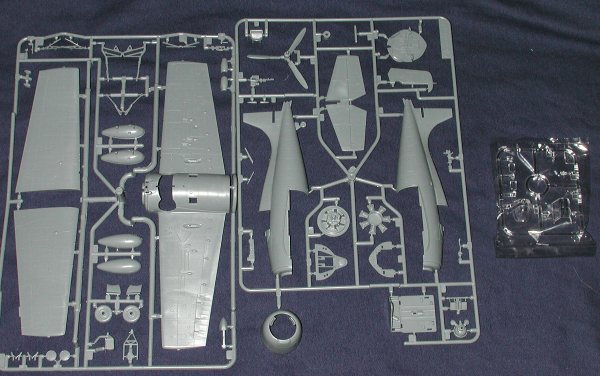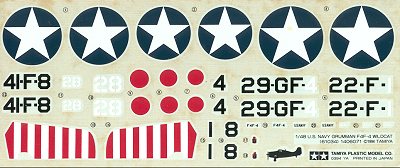
|
KIT: |
Tamiya 1/48 F4F-4 Wildcat |
|
KIT # |
61034 |
|
PRICE: |
$26 |
|
DECALS: |
Three aircraft |
|
REVIEW & |
|
|
NOTES: |

|
HISTORY |
I don't think it is too much to say that if it hadn't been for the Wildcat, that America's early war in the Pacific would have been much worse than what it was. I just can't imagine how successful pilots flying the F2A Buffalo would have been against the A6M Zero. The Grumman was a much more rugged plane than the Buffalo and though the Finns did wonders with theirs during the war with the Russians, they were not fighting the vastly superior forces of the Japanese.
Throughout the 'dark days' of the early war the Wildcat was able to give better than it got and kept the Japanese from too much success with their bombers; both land and carrier-based. It then soldiered on for years afterwards as the main fighter on the smaller 'jeep' carriers, giving support to the larger task forces or to convoys.
|
THE KIT |

It may seem a bit odd to be doing a preview of a kit that has been the subject of at least a half dozen reviews here on Modeling Madness, but none of those reviews show what the kit is like before the glue and paint are applied. The Wildcat was the third kit of the new Tamiya aircraft kits that were released in the early 1990s. They started with the Spit I and V and the line has grown a great deal over the convening years.
Tamiya stopped producing new aircraft kits after the 1/50 series and a stab at the Lancaster in the late '60s, early '70s. The only other kit released prior to the Spit I was the F2A Buffalo and it didn't seem to take off the way Tamiya had hoped. Well the new series of 1/48 and now 1/72 models has done extremely well. Each is superbly engineered and fits very well. About the only flak that Tamiya has gotten has been when it made a few gaffes in choosing the subject, picking museum prototypes which were not exactly what they has appeared to be (the Meteor being a prime example).
The Wildcat kit has a gaffe or two in it as well. For one thing it has a full interior floor instead of the troughs to allow the pilot to see out the lower windows. It also only has one intercooler radiator instead of the two that the real aircraft had. Other than that, it appears to be a fairly straight-forward and simple kit to build.
There are two large sprues of grey plastic along with a clear sprue and some of those plastic grommets to hold in the prop. The only real options on the kit are open or closed canopy and drop tanks. Frankly, most will do away with the drop tanks as they just look odd on the plane. The detailing is very good and there are plenty of rivets on the kit just like the real aircraft. Only these are pretty close to scale and not the 'golf balls' of older kits.
 Decals are for three aircraft.
Though my kit was sealed, it is obvious that the decal sheet has suffered water
damage and is probably unusable (the downside of buying kits from swap meets).
No worries as there are plenty of aftermarket sheets out there to replace them.
The kit offers four schemes, the first three in a medium blue over a light
blue-grey. First is a VF-41 bird with red and white rudder stripes. Next a
VMF-223 Wildcat for the Marines, then a VGF-29 F4F-4 from the USS Santee and
finally a VF-22 plane from the USS Independence in the mid-war tri-color scheme.
Decals are for three aircraft.
Though my kit was sealed, it is obvious that the decal sheet has suffered water
damage and is probably unusable (the downside of buying kits from swap meets).
No worries as there are plenty of aftermarket sheets out there to replace them.
The kit offers four schemes, the first three in a medium blue over a light
blue-grey. First is a VF-41 bird with red and white rudder stripes. Next a
VMF-223 Wildcat for the Marines, then a VGF-29 F4F-4 from the USS Santee and
finally a VF-22 plane from the USS Independence in the mid-war tri-color scheme.
|
CONCLUSIONS |
If you are like me and haven't built one yet, I'd suggest hopping to it. All the full-build reviews tell you how easy the kit is to build and I don't doubt it one bit.
Review kit courtesy of me and my wallet!
If you would like your product reviewed fairly and quickly by a site that has thousands of visits a day, please contact me or see other details in the Note to Contributors.